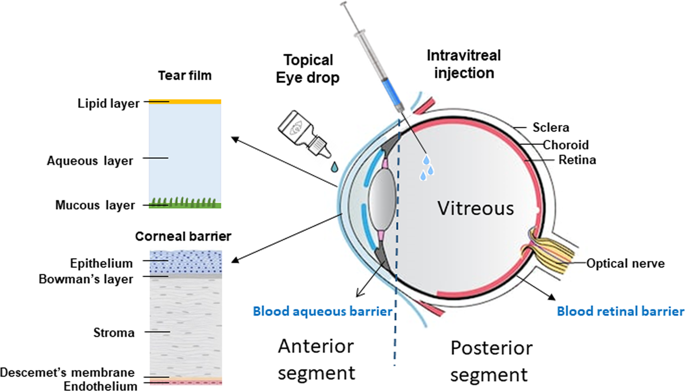Our official English website, www.x-mol.net, welcomes your
feedback! (Note: you will need to create a separate account there.)
Use of biomaterials for sustained delivery of anti-VEGF to treat retinal diseases
Eye ( IF 2.8 ) Pub Date : 2020-01-30 , DOI: 10.1038/s41433-020-0770-y Ivan Seah 1 , Xinxin Zhao 2 , Qianyu Lin 3 , Zengping Liu 2, 4, 5 , Steven Zheng Zhe Su 6 , Yew Sen Yuen 1 , Walter Hunziker 2, 6, 7 , Gopal Lingam 1, 4 , Xian Jun Loh 3 , Xinyi Su 1, 2, 4, 5
Eye ( IF 2.8 ) Pub Date : 2020-01-30 , DOI: 10.1038/s41433-020-0770-y Ivan Seah 1 , Xinxin Zhao 2 , Qianyu Lin 3 , Zengping Liu 2, 4, 5 , Steven Zheng Zhe Su 6 , Yew Sen Yuen 1 , Walter Hunziker 2, 6, 7 , Gopal Lingam 1, 4 , Xian Jun Loh 3 , Xinyi Su 1, 2, 4, 5
Affiliation

|
Anti-vascular endothelial growth factors (anti-VEGF) have become the most common treatment modality for many retinal diseases. These include neovascular age-related macular degeneration (n-AMD), proliferative diabetic retinopathy (PDR) and retinal vein occlusions (RVO). However, these drugs are administered via intravitreal injections that are associated with sight-threatening complications. The most feared of these complications is endophthalmitis, a severe infection of the eye with extremely poor visual outcomes. Patients with retinal diseases typically have to undergo multiple injections before achieving the desired therapeutic effect. Each injection incurs the risk of the sight-threatening complications. As such, there has been great interest in developing sustained delivery platforms for anti-VEGF agents to the posterior segment of the eye. In recent years, there have been various strategies that have been conceptualised. These include non-biodegradable implants, nano-formulations and hydrogels. In this review, the barriers of drug delivery to the posterior segment of the eye will be explained. The characteristics of an ideal sustained delivery platform will then be discussed. Finally, the current available strategies will be analysed with the above-mentioned characteristics in mind to determine the advantages and disadvantages of each sustained drug delivery modality. Through the above, this review attempts to provide an overview of the sustained delivery platforms in their various phases of development.
中文翻译:

使用生物材料持续递送抗 VEGF 治疗视网膜疾病
抗血管内皮生长因子 (anti-VEGF) 已成为许多视网膜疾病最常见的治疗方式。这些包括新生血管性年龄相关性黄斑变性 (n-AMD)、增殖性糖尿病视网膜病变 (PDR) 和视网膜静脉阻塞 (RVO)。然而,这些药物是通过与威胁视力的并发症相关的玻璃体内注射给药的。这些并发症中最令人恐惧的是眼内炎,这是一种严重的眼部感染,视力极差。患有视网膜疾病的患者通常需要经过多次注射才能达到预期的治疗效果。每次注射都会带来威胁视力的并发症的风险。因此,人们对开发将抗 VEGF 药物持续递送至眼后段的平台产生了极大的兴趣。近年来,已经出现了各种概念化的策略。其中包括不可生物降解的植入物、纳米制剂和水凝胶。在这篇综述中,将解释药物输送到眼后节的障碍。然后将讨论理想的持续交付平台的特征。最后,将结合上述特点分析当前可用的策略,以确定每种持续给药方式的优缺点。通过以上内容,本综述试图对处于不同发展阶段的持续交付平台进行概述。将解释药物输送到眼睛后段的障碍。然后将讨论理想的持续交付平台的特征。最后,将结合上述特点分析当前可用的策略,以确定每种持续给药方式的优缺点。通过以上内容,本综述试图对处于不同发展阶段的持续交付平台进行概述。将解释药物输送到眼睛后段的障碍。然后将讨论理想的持续交付平台的特征。最后,将结合上述特点分析当前可用的策略,以确定每种持续给药方式的优缺点。通过以上内容,本综述试图对处于不同发展阶段的持续交付平台进行概述。
更新日期:2020-01-30
中文翻译:

使用生物材料持续递送抗 VEGF 治疗视网膜疾病
抗血管内皮生长因子 (anti-VEGF) 已成为许多视网膜疾病最常见的治疗方式。这些包括新生血管性年龄相关性黄斑变性 (n-AMD)、增殖性糖尿病视网膜病变 (PDR) 和视网膜静脉阻塞 (RVO)。然而,这些药物是通过与威胁视力的并发症相关的玻璃体内注射给药的。这些并发症中最令人恐惧的是眼内炎,这是一种严重的眼部感染,视力极差。患有视网膜疾病的患者通常需要经过多次注射才能达到预期的治疗效果。每次注射都会带来威胁视力的并发症的风险。因此,人们对开发将抗 VEGF 药物持续递送至眼后段的平台产生了极大的兴趣。近年来,已经出现了各种概念化的策略。其中包括不可生物降解的植入物、纳米制剂和水凝胶。在这篇综述中,将解释药物输送到眼后节的障碍。然后将讨论理想的持续交付平台的特征。最后,将结合上述特点分析当前可用的策略,以确定每种持续给药方式的优缺点。通过以上内容,本综述试图对处于不同发展阶段的持续交付平台进行概述。将解释药物输送到眼睛后段的障碍。然后将讨论理想的持续交付平台的特征。最后,将结合上述特点分析当前可用的策略,以确定每种持续给药方式的优缺点。通过以上内容,本综述试图对处于不同发展阶段的持续交付平台进行概述。将解释药物输送到眼睛后段的障碍。然后将讨论理想的持续交付平台的特征。最后,将结合上述特点分析当前可用的策略,以确定每种持续给药方式的优缺点。通过以上内容,本综述试图对处于不同发展阶段的持续交付平台进行概述。











































 京公网安备 11010802027423号
京公网安备 11010802027423号